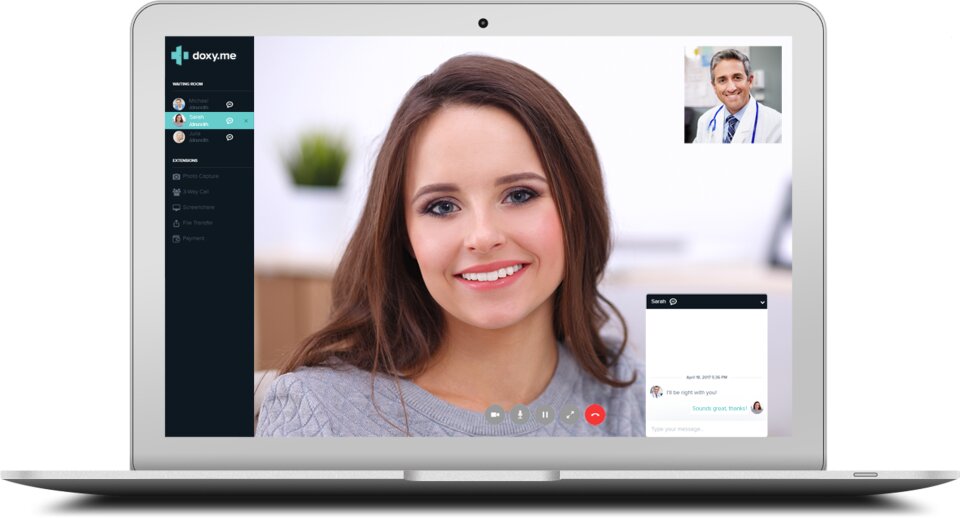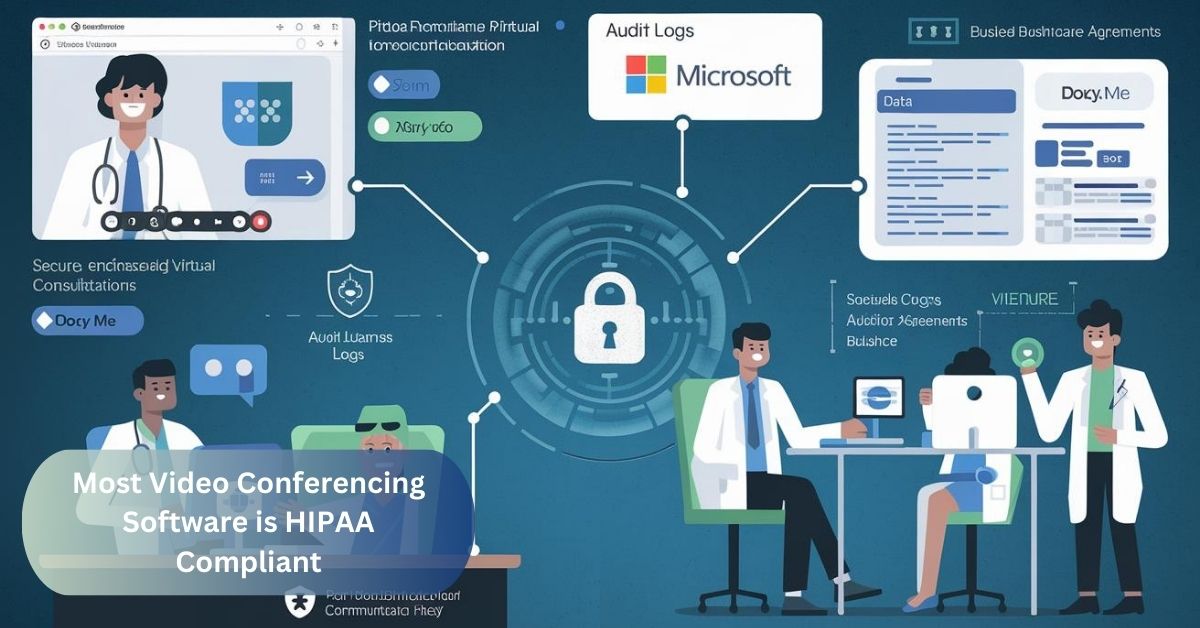In the digital age, video conferencing has become an integral tool for industries, especially healthcare, where professionals interact with patients remotely.
Most video conferencing software used in healthcare is HIPAA compliant, meaning it meets strict regulations to protect patient information. Platforms like Zoom for Healthcare, Microsoft Teams, and Doxy.me ensure secure, encrypted communications. Always check for a signed Business Associate Agreement (BAA) for compliance.
This article explores the landscape of video conferencing tools, their compliance with HIPAA, and how healthcare providers can ensure their digital communications meet legal and security standards.
Understanding HIPAA and its Importance in Video Conferencing:
1. What is HIPAA?
HIPAA, enacted in 1996, is a federal law aimed at protecting sensitive patient data. It outlines stringent requirements for healthcare providers and their partners when handling patient information. Any platform or service that stores, transmits, or interacts with PHI must adhere to HIPAA guidelines to prevent unauthorized access or misuse.
2. Why Video Conferencing Needs to Be HIPAA Compliant
With telemedicine gaining popularity, video conferencing software has become a necessity for patient consultations, discussions among healthcare professionals, and sharing medical information. As PHI is frequently transmitted during these virtual meetings, non-compliant tools could expose sensitive data, leading to violations, hefty fines, and damaged reputations.
Key Features That Make Video Conferencing Software HIPAA Compliant:
Not all video conferencing tools are created equal. For a software to be HIPAA compliant, it must incorporate a series of security features and legal protocols that protect PHI during online communications.

- End-to-End Encryption: End-to-end encryption ensures that only the sender and receiver can access the content of the communication. This type of encryption prevents unauthorized third parties, including the software provider, from intercepting or viewing PHI.
- Access Control: HIPAA-compliant software should provide strong user authentication protocols. This includes requiring users to create strong passwords, use two-factor authentication (2FA), and implement role-based access to sensitive data. By limiting access to authorized personnel only, the software reduces the risk of data breaches.
- Audit Controls: Audit trails or logs allow organizations to track who accessed the system, what actions were performed, and when these actions occurred. HIPAA requires healthcare providers to maintain records of how PHI is handled, which audit controls facilitate.
- Business Associate Agreement (BAA): One of the most critical requirements for a video conferencing platform to be HIPAA compliant is the signing of a Business Associate Agreement. This contract between the healthcare provider and the software vendor ensures that the vendor will protect PHI and comply with HIPAA regulations.
- Data Encryption and Storage: HIPAA also requires that any stored PHI be encrypted at rest. This protects sensitive information if servers or databases are compromised. The software must also implement data destruction policies to ensure that PHI is deleted when no longer needed.
Popular HIPAA-Compliant Video Conferencing Platforms:
Several video conferencing platforms meet HIPAA compliance standards, making them ideal for healthcare providers. Let’s explore some of the most popular options.
1. Zoom for Healthcare
Zoom has become synonymous with video conferencing, but only the healthcare-specific version of Zoom is HIPAA compliant. The platform offers encrypted data transmission, role-based access control, and a signed BAA. Zoom for Healthcare is designed specifically to meet the needs of medical professionals who handle PHI.
2. Microsoft Teams (Healthcare Edition)
Microsoft Teams offers a HIPAA-compliant version designed for the healthcare industry. It provides encryption, audit logs, and a secure environment for telemedicine. Microsoft also offers a BAA, ensuring the platform complies with HIPAA’s privacy and security regulations.
3. Doxy.me

Doxy.me is a simple, web-based telemedicine solution built for healthcare providers. It is HIPAA compliant by default and offers end-to-end encryption without requiring software installation. The platform is particularly favored for its user-friendly interface and ease of access for patients and providers alike.
4. VSee
VSee is another telemedicine platform that provides HIPAA-compliant video conferencing solutions. It is highly customizable and offers encrypted video calls, access control, and audit logging to ensure PHI remains secure during virtual appointments.
5. Google Meet (Enterprise Edition)
Google Meet’s Enterprise Edition offers HIPAA compliance when used in conjunction with Google Workspace. Healthcare providers can use Google Meet for secure telehealth appointments, provided they sign a BAA with Google.
Challenges and Risks in Using Non-Compliant Video Conferencing Software:
Using non-HIPAA-compliant software for healthcare communications poses significant risks, including:
- Data Breaches: Non-compliant platforms often lack adequate security measures, increasing the risk of PHI being intercepted by hackers or unauthorized third parties.
- Legal and Financial Consequences: Healthcare providers found in violation of HIPAA regulations can face fines ranging from $100 to $50,000 per violation. Severe breaches can result in criminal charges and massive financial penalties.
- Loss of Patient Trust: A data breach involving PHI can severely damage a healthcare provider’s reputation. Patients expect their private health information to remain confidential, and any lapse in security can erode trust.
Ensuring HIPAA Compliance in Your Video Conferencing Software:
To safeguard PHI and maintain compliance, healthcare providers should take several steps when selecting and using video conferencing software.

1. Evaluate the Software’s Security Features
Before choosing a platform, ensure that it offers the necessary security features, such as encryption, user authentication, and audit trails. Platforms like Zoom for Healthcare and Microsoft Teams provide these features as part of their HIPAA-compliant packages.
2. Sign a BAA with the Vendor
A Business Associate Agreement is mandatory for HIPAA compliance. Without it, the software provider cannot be held accountable for safeguarding PHI. Ensure that your chosen platform offers a BAA and that it’s properly signed and documented.
3. Train Staff on HIPAA Best Practices
Even with the most secure software, human error can lead to data breaches. Ensure that your staff is trained in HIPAA regulations, including how to properly handle PHI, secure communications, and avoid unauthorized data sharing.
4. Regularly Audit and Monitor Software Use
Conduct regular audits of your video conferencing software to ensure that PHI is being handled according to HIPAA regulations. Implement monitoring protocols to detect unauthorized access or suspicious activity.
5. Keep Software Updated
Software updates often include security patches and enhancements. Ensure that your video conferencing platform is kept up to date to maintain the highest levels of security and compliance.
The Future of HIPAA-Compliant Video Conferencing:

With the increasing demand for telemedicine, video conferencing technology will continue to evolve. As healthcare becomes more reliant on digital tools, the need for robust HIPAA-compliant solutions will only grow. Emerging technologies like artificial intelligence and machine learning could play a role in enhancing the security and functionality of video conferencing platforms in the future.
FAQ’s
1. What is HIPAA compliance in video conferencing?
HIPAA compliance in video conferencing ensures that the software used for telemedicine and patient consultations meets federal regulations for protecting personal health information.
2. Can I use Zoom for healthcare-related video conferencing?
Yes, Zoom for Healthcare is a HIPAA-compliant version of the standard Zoom platform. It includes enhanced security features and requires a signed BAA.
3. Do all video conferencing platforms offer HIPAA compliance?
No, not all video conferencing platforms are HIPAA compliant. Only those that meet specific security and privacy standards, such as end-to-end encryption and audit controls, are compliant.
4. What happens if I use non-HIPAA-compliant software in healthcare?
Using non-HIPAA-compliant software for healthcare purposes can result in data breaches, legal penalties, and significant fines, as well as a loss of patient trust.
5. How do I know if my video conferencing software is HIPAA compliant?
You can verify HIPAA compliance by checking if the software offers necessary security features and whether the vendor provides a Business Associate Agreement.
6. Is Microsoft Teams HIPAA compliant?
Yes, the healthcare version of Microsoft Teams is HIPAA compliant when used with the appropriate security settings and a signed BAA.
7. Can Google Meet be used for telemedicine?
Yes, Google Meet’s Enterprise Edition can be HIPAA compliant when used within the Google Workspace platform, and a BAA is signed.
8. What is a Business Associate Agreement (BAA)?
A BAA is a legal contract between a healthcare provider and a service provider that handles PHI. It ensures that both parties comply with HIPAA regulations.
9. Is Doxy.me a good platform for telemedicine?
Yes, Doxy.me is a HIPAA-compliant telemedicine platform that is easy to use and offers encrypted communications without requiring software installation.
Closing Remarks:
In the healthcare industry, protecting patient information is paramount, and HIPAA compliance is non-negotiable. Healthcare providers must ensure that the video conferencing software they use meets HIPAA’s stringent requirements.
By choosing a compliant platform, signing a BAA, and maintaining proper security protocols, organizations can confidently offer telemedicine services while safeguarding patient privacy.

